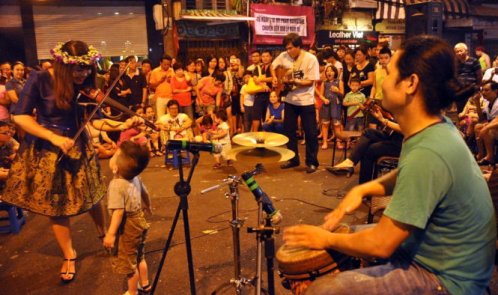The ancient quarter of Hanoi, with its narrow, busy streets, has become more animated this month thanks to the presence of bands performing both contemporary and folk music every weekend.
The pedestrian-only streets have been tuned up with regular, free performances by bands at six intersections in the quarter on Friday, Saturday, and Sunday.
Though street music is popular around the world, this marks the first time such music has been organized in Hanoi.
It helps attract tourists, enliven the ancient quarter, and preserve traditional folk music, said professor and researcher Ngo Duc Thinh. It brings both economic and cultural benefits.
Street music matched with street food helps spice up the experience of travelers.
The free performances start at 8:30pm every Friday, Saturday, and Sunday, but the locations where they take place are often full with expectant crowds half an hour earlier. Children are free to sit right on the road to watch the live shows.
Music for the standing crowd
The management board of Hanoi’s ancient quarter said they organize six bands at six different locations in the quarter each weekend.
The three sites for contemporary music are at the intersections of Hang Buom and Ma May, Ta Hien and Luong Ngoc Quyen, and Ta Hien – Hang Buom; while the three locations for folk music are the Bach Ma, Quan De and Huong Tuong temples.
They are under the organization and management of the Hanoi Department of Culture, Sports, and Tourism.
“I’ve come to Hanoi many times but this is the most joyful day thanks to the music being performed on the streets,” said Hoang Dung, 43, from the Central Highlands province of Gia Lai.
“The audience members have never met one another before but we feel familiar and join in the rhythms of music right on the street.”
The different types of folk music available on the streets of Hanoi now include ‘ca trù,’ which originated as a royal art performance of academic characters that has been preserved for 10 centuries; ‘hát trống quân,’ which is a type of popular art that alternates songs with drum accompaniments and performances by musical instruments. ‘Hát xẩm’ is also featured.
“I’ve lived in Hanoi for 67 years but have never watched street music here,” said Tran Le Huong, a resident on Hang Bac Street in Hoan Kiem District.
“Folk music like ca trù, hát xẩm and chầu văn always attracts us,” she added.
Foreign tourists also join the crowd to dance to the rhythms of traditional music.
“It’s attractive and surprises me,” said a visitor from the Netherlands.
Mayr, a 26 year old woman from Spain, said “I don’t understand the language but enjoy the way they dance, it’s strange and interesting.”
The audience at the Ta Hien – Luong Ngoc Quyen intersection, which is known to locals as the ‘international crossroad’ because of the presence of foreign tourists, not only watches and listens to the music, but also dances to folk and contemporary music.
Lam Nguyen, vice head of the opera department of the Hanoi Art College and head of the Magic band, which performs at the ‘international crossroad’, said, “Street music is often performed by amateurs in other countries, but in Vietnam, it is performed by well-trained artists.
“I see cheerful audiences and inspired, smiling artists watching street music here.
“This is also the difference between music in a theater and on the streets.”
He added, “Members of my band are eagerly waiting to begin performing here. We feel like we are missing something on days we don’t perform. We are more motivated here.”
Musician Thao Giang said, “Some days we move the site of the performance, but the spots are always crowded.”
“I am excited to see foreign tourists cheering and dancing to the rhythms we perform on the street,” he said.
“Music brings people closer together.
“At the end of a performance, the audience talks with us and they tell us what songs and what kinds of music they would like to hear next week. It’s very exciting to hear.”
Tran Thuy Lan, vice head of the management board of Hanoi’s ancient quarter, said, “Street music will be organized regularly on weekends in the long term.
“We have received impressive feedback and will promote it,” she added.
She admitted that she will consider changing the spaces used for performances because of the large crowds gathering on the narrow streets of the area.



















































